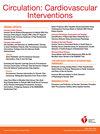冠状动脉慢速血流的目测值与基于侵入性导线的冠状动脉微血管功能障碍诊断结果无关
IF 6.1
1区 医学
Q1 CARDIAC & CARDIOVASCULAR SYSTEMS
Circulation: Cardiovascular Interventions
Pub Date : 2024-04-07
DOI:10.1161/circinterventions.123.013902
引用次数: 0
摘要
背景:通过有创冠状动脉造影检查冠状动脉慢血流(CSF)通常被认为是冠状动脉缺血伴非阻塞性冠状动脉(INOCA)患者冠状动脉微血管功能障碍(CMD)的指标。然而,CSF 的视觉估计值与基于导线的冠状动脉微血管功能障碍定量有创诊断之间的关系尚不确定:我们前瞻性地招募了年龄≥18 岁、患有稳定型缺血性心脏病并转诊接受有创冠状动脉造影术的成年人。心外膜冠状动脉狭窄≥50%者除外。对有创冠状动脉造影进行CSF复查,CSF的定义是造影剂使远端血管通透的心动周期≥3个。使用栓塞冠状动脉热稀释技术在左前降支(LAD)冠状动脉进行冠状动脉功能测试,以测量冠状动脉血流储备(CFR)和微循环阻力指数(IMR)。有创CMD定义为CFR异常(<2.5)、IMR异常(≥25)或两者皆有:104名参与者中,中位年龄为61.5岁,79%为女性。CFR中位数为3.6(IQR为2.5-4.7),IMR中位数为21(IQR为13.3-28.0)。总体而言,24.0%的参与者CFR异常,34.6%的参与者IMR异常,48.1%的参与者最终诊断为有创CMD。有 23 名参与者(22.1%)出现 CSF。有CMD(56.5% vs 45.7%,P=0.36)、CFR异常(17.4% vs 25.9%,P=0.40)和IMR异常(43.5% vs 32.1%,P=0.31)的患者比例在有CSF和无CSF的患者中没有差异:结论:在 INOCA 患者中,CSF 与 CFR、IMR 异常或 CFR 或 IMR 异常均无关。CSF不是有创线生理检测确定的异常CFR或IMR的可靠血管造影替代物。本文章由计算机程序翻译,如有差异,请以英文原文为准。
Visual Estimates of Coronary Slow Flow Are Not Associated with Invasive Wire-Based Diagnoses of Coronary Microvascular Dysfunction
Background: Coronary slow flow (CSF) by invasive coronary angiography is frequently understood to be an indicator of coronary microvascular dysfunction (CMD) in patients with ischemia with non-obstructive coronary arteries (INOCA). However, the relationship between visual estimates of CSF and quantitative wire-based invasive diagnosis of CMD is uncertain.Methods: We prospectively enrolled adults age ≥18 years with stable ischemic heart disease who were referred for invasive coronary angiography. Individuals with ≥50% epicardial coronary artery stenosis were excluded. Invasive coronary angiography was reviewed for CSF, defined as ≥3 cardiac cycles to opacify distal vessels with contrast. Coronary function testing was performed in the left anterior descending (LAD) coronary artery using bolus coronary thermodilution techniques to measure coronary flow reserve (CFR) and the index of microcirculatory resistance (IMR). Invasively determined CMD was defined as abnormal CFR (<2.5), abnormal IMR (≥25), or both.Results: Among 104 participants, the median age was 61.5 and 79% were female. The median CFR was 3.6 (IQR 2.5-4.7) and the median IMR was 21 (IQR 13.3-28.0). Overall, 24.0% of participants had abnormal CFR, 34.6% had abnormal IMR, and 48.1% had a final diagnosis of invasively determined CMD. CSF was present in 23 participants (22.1%). The proportions of patients with CMD (56.5% vs 45.7%, p=0.36), abnormal CFR (17.4% vs 25.9%, p=0.40) and abnormal IMR (43.5% vs. 32.1%, p=0.31) were not different in patients with versus without CSF.Conclusions: Among patients with INOCA, CSF was not associated with abnormal CFR, IMR, or either abnormal CFR or IMR. CSF is not a reliable angiographic surrogate of abnormal CFR or IMR as determined by invasive, wire-based physiology testing.
求助全文
通过发布文献求助,成功后即可免费获取论文全文。
去求助
来源期刊

Circulation: Cardiovascular Interventions
CARDIAC & CARDIOVASCULAR SYSTEMS-
CiteScore
10.30
自引率
1.80%
发文量
221
审稿时长
6-12 weeks
期刊介绍:
Circulation: Cardiovascular Interventions, an American Heart Association journal, focuses on interventional techniques pertaining to coronary artery disease, structural heart disease, and vascular disease, with priority placed on original research and on randomized trials and large registry studies. In addition, pharmacological, diagnostic, and pathophysiological aspects of interventional cardiology are given special attention in this online-only journal.
 求助内容:
求助内容: 应助结果提醒方式:
应助结果提醒方式:


